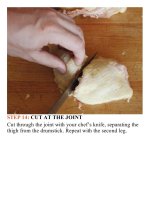The food lab better home cooking through science ( PDFDrive ) 717
Bạn đang xem bản rút gọn của tài liệu. Xem và tải ngay bản đầy đủ của tài liệu tại đây (133.67 KB, 2 trang )
LETITREST!
Resting is key to making any roast poultry dinner,
particularlyahecticonelikeThanksgiving,botheasierand
tastier. Resting allows time for the meat to relax and the
internal juices to redistribute themselves evenly throughout
it. Additionally, the slightly cooler temperature will cause
themeat’sjuicestothickenconsiderably,makingthemless
likelytoflowoutofthebirdwhenyoucarveit(formoreon
resting,seehereandhere).
I let my birds rest until their internal temperature has
dropped down to 143°F or less. For a chicken cooked to
150°F,thiswilltakebetween10and15minutes;fora10-to
12-poundturkey,itcantakeover30minutes.Butconsider
that an added bonus: you’ve now got an extra half hour to
do things like deglaze your pan drippings, heat up your
casseroles, have a cocktail, and make whipped cream to
coverupthefingerprintsyouleftonthepumpkinpie.
WHATABOUTFLAVOR?
To be perfectly frank, 90 percent of the time I roast a
chicken, I rely on salt and pepper alone—if you’ve got
yourself a really great chicken, its flavor should speak for
itself.Butwhatifyouwanttoaddalittleextrasomethingto
it?
Here’s the good news: once you have the basic roasting
techniques down, adding flavor is as simple as a good rub
or some herbs applied before cooking; the actual cooking
method is exactly the same.Those dozens or hundreds of
chickenrecipesyoucanfindonlineforherb-rubbedthisor
lemon that? They’re really all the same old roast chicken
withafewflavorsaddedtoit.Whatthatmeansisthatonce
you understand what makes chicken good (proper roasting
technique,notovercookingthebreasts,allowingtheskinto
render),howyouflavorthebirdisentirelyuptoyou.
Togetyoustarted,Iputtogetheralittlechartthatshows
youhowtoapplyvariousflavorstoyourbird,alongwitha
few specific recipe variations that I enjoy. Of course you
can mix and match all of these flavoring agents as desired.
In the chart, I haven’t listed any salt, because in the two
basicrecipesthatfollow,thechickenisseasonedseparately
with salt. But you can just as easily add the salt directly to
anyherbruborspicemixturetoseasonandflavorthebird
inonestep.
FLAVORING HOWTOAPPLY
AGENT
Tender,
LeafyHerbs
(parsley,
basil,
tarragon,
cilantro,etc.)
Finelychop½cup
freshherbleavesby
handorinafood
processor.Combine
with1to2
tablespoonsoliveoil









